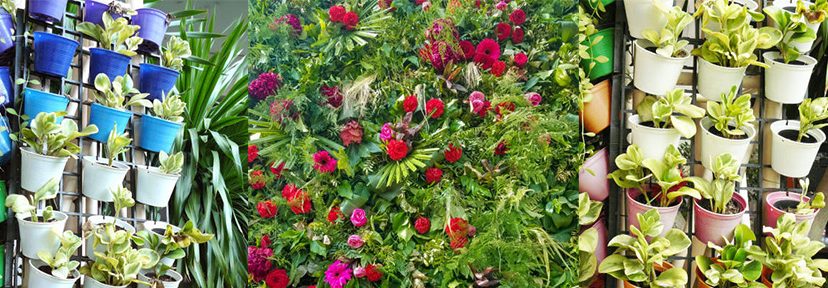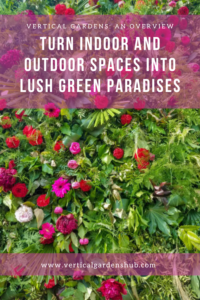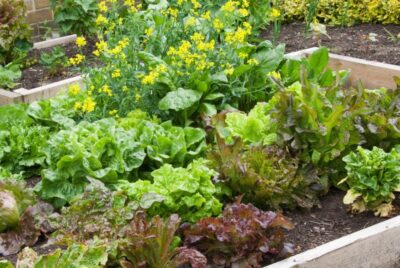Vertical Gardens: An Overview
Vertical gardens have become increasingly popular in recent years, transforming both indoor and outdoor spaces into lush green paradises. We’ll explore the concept of vertical gardens, their benefits, types, essential considerations, and provide practical tips to help you create your own stunning vertical garden.
In this Article:
- What are Vertical Gardens?
- Benefits
- Types
- Choosing the Right Location
- Selecting the Ideal Plants
- Designs
- Maintenance
- Irrigation Systems
- Enhancing Sustainability
- DIY Projects
- In Urban Areas
- For Small Spaces
- In Commercial Spaces
- Conclusion
- FAQs
This article contains affiliate links to products for your convenience. Vertical Gardens Hub may earn a small commission from purchases made through these links at no additional cost to you. Please see our disclaimer to learn more.
What are Vertical Gardens?
Vertical gardens, also known as living walls or green walls, are a creative way to grow plants vertically on a wall or any vertical surface. Instead of traditional horizontal gardening, vertical gardens utilize vertical space, making them ideal for small areas, urban environments, and those who want to add a touch of nature to their surroundings. These gardens can be created using various techniques and materials, such as modular systems, trellises, hydroponics, or even repurposed items.
Benefits of Vertical Gardens
Vertical gardens offer a multitude of benefits, making them a fantastic addition to any space. Firstly, they enhance air quality by filtering pollutants and releasing oxygen, creating a healthier environment. Additionally, vertical gardens help to insulate buildings, reducing energy consumption and providing a natural cooling effect. They also absorb sound, making them an excellent option for noise reduction in urban areas. And, vertical gardens contribute to biodiversity, attracting beneficial insects and birds, thus promoting a more balanced ecosystem.
Vertical Garden Types
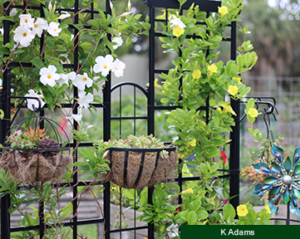 There are several types of vertical gardens to choose from based on your preferences and available space.
There are several types of vertical gardens to choose from based on your preferences and available space.
- The modular system, which consists of individual plant containers that can be easily attached to a wall or framework.
- A trellis-based vertical garden, where climbing plants are trained to grow on a lattice structure.
- A hydroponics vertical garden can be created using a soilless system that provides plants with nutrients and water directly. Plants may be suspended in water full time or by an intermittent flow of water.
- Aeroponic vertical gardens are like a hydroponic garden but a plants roots are not placed into water. Nutrients are from a mist that is sprayed on their roots.
- An aquaponics vertical garden is a “closed loop system” way to grow plants using water circulated from fish tanks.
- Repurposing old items like pallets or shoe organizers can serve as a creative and cost-effective way to build a vertical garden.
Choosing the Right Location
Selecting the right location is crucial for the success of your vertical garden. Before installing one, consider factors such as sunlight exposure, wind conditions, and accessibility. Most plants require a minimum of six hours of sunlight each day, so ensure that your chosen location receives adequate natural light. If you plan to grow shade-loving plants, place your vertical garden in a shaded area. Furthermore, protect your vertical garden from strong winds that may damage delicate plants and ensure your garden is easily accessible for watering, maintenance, and harvesting.
Selecting the Ideal Plants
 When choosing the right plants to create a thriving vertical garden consider the available light, humidity levels, and maintenance requirements when selecting plants. Choose plants that are well-suited for vertical growth, such as trailing vines, ferns, herbs, and compact flowering plants. It’s also important to choose plants that have similar water and sunlight requirements to ensure balanced growth. Remember to research the growth habits of your selected plants to determine if they need support structures or special care.
When choosing the right plants to create a thriving vertical garden consider the available light, humidity levels, and maintenance requirements when selecting plants. Choose plants that are well-suited for vertical growth, such as trailing vines, ferns, herbs, and compact flowering plants. It’s also important to choose plants that have similar water and sunlight requirements to ensure balanced growth. Remember to research the growth habits of your selected plants to determine if they need support structures or special care.
Also read:
- Vertical Garden Systems: Types, Benefits and Considerations
- Vertical Gardening Plants: A Practical Guide
- Indoor Vertical Garden Ideas: 20 Unique Examples
- Outdoor Vertical Garden Ideas: 20 Creative Examples
Designs
Designing your vertical garden allows you to unleash your creativity and personalize your space. Start by envisioning the overall look and feel you want to achieve. Consider using a variety of plant textures, colors, and heights to create visual interest. Arrange the plants in a way that allows for optimal growth and ensures each plant receives adequate light. Incorporate different containers, trellises, or modular systems to add depth and dimension to your vertical garden. Don’t be afraid to experiment and let your garden reflect your unique style.
Maintenance
To keep your vertical garden healthy and thriving, regular maintenance is necessary. Regularly inspect your plants for signs of pests, diseases, or nutrient deficiencies. Prune and trim as needed to maintain the desired shape and to prevent overcrowding. Monitor the moisture levels of your plants’ root systems and water accordingly. It’s important not to overwater or underwater your plants, as both can lead to problems. Consider using organic fertilizers or compost to provide the necessary nutrients for your plants’ growth. Lastly, remove any dead or wilted leaves to maintain the overall aesthetics of your vertical garden.
Irrigation
Proper irrigation is vital for the success of your vertical garden. There are several irrigation systems to choose from, depending on your budget, space, and personal preferences. Consider the needs of your plants, water availability, and your lifestyle when deciding on the most suitable irrigation system.
- Drip irrigation systems deliver water directly to the plant roots, ensuring efficient water usage and minimizing evaporation.
- A low-tech approach, hand-watering using a watering can or hose with a gentle spray attachment can be effective.
- Automated irrigation systems with timers can provide convenience, and precise watering schedules.
Enhancing Sustainability
Vertical gardens can contribute to sustainability efforts by incorporating eco-friendly practices.
- Use organic soil and fertilizers to minimize chemical exposure.
- Collect and reuse rainwater whenever possible to reduce water consumption.
- Implement a composting system to create nutrient-rich soil amendments.
Furthermore, explore the possibility of integrating renewable energy sources, such as solar panels, to power irrigation systems or lighting. By adopting sustainable practices, you can create a green space that aligns with your environmental values.
DIY Projects
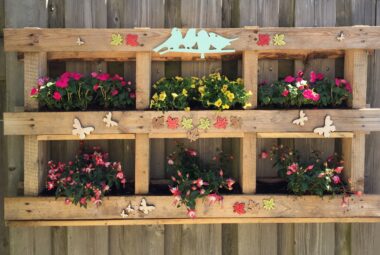 Creating your own vertical garden through DIY projects can be a rewarding and cost-effective endeavor. From repurposing old wooden pallets as planters to using plastic bottles as modular containers, the possibilities are endless. Explore tutorials and guides online for step-by-step instructions on constructing various types of vertical gardens. DIY vertical gardens not only allow you to express your creativity but also provide a sense of pride and accomplishment as you witness your creation flourish.
Creating your own vertical garden through DIY projects can be a rewarding and cost-effective endeavor. From repurposing old wooden pallets as planters to using plastic bottles as modular containers, the possibilities are endless. Explore tutorials and guides online for step-by-step instructions on constructing various types of vertical gardens. DIY vertical gardens not only allow you to express your creativity but also provide a sense of pride and accomplishment as you witness your creation flourish.
Vertical Gardens in Urban Areas
Vertical gardens have gained popularity in urban areas due to their ability to bring nature into concrete jungles. They provide an opportunity for city dwellers to connect with nature, improve air quality, and reduce the urban heat island effect. Additionally, vertical gardens on building facades can improve the aesthetics of the surrounding area, making it more visually appealing and pleasant for residents and passersby. Urban vertical gardens can also promote food production in limited spaces, allowing individuals to grow fresh herbs, vegetables, or fruits right at their doorstep.
Vertical Gardens for Small Spaces
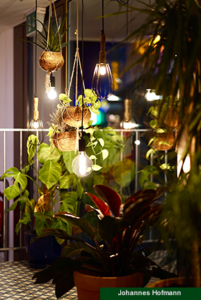 One of the significant advantages of vertical gardens is their suitability for small spaces. Whether you have a tiny balcony, a narrow alleyway, or a compact backyard, vertical gardens can transform these areas into green oases. Utilize hanging baskets, wall-mounted planters, or pocket planters to maximize vertical space. Herbs, succulents, and compact flowering plants are excellent choices for small vertical gardens. By utilizing vertical space, you can enjoy the benefits of gardening even in the smallest of areas.
One of the significant advantages of vertical gardens is their suitability for small spaces. Whether you have a tiny balcony, a narrow alleyway, or a compact backyard, vertical gardens can transform these areas into green oases. Utilize hanging baskets, wall-mounted planters, or pocket planters to maximize vertical space. Herbs, succulents, and compact flowering plants are excellent choices for small vertical gardens. By utilizing vertical space, you can enjoy the benefits of gardening even in the smallest of areas.
Vertical Gardens in Commercial Spaces
Vertical gardens have found their place in commercial spaces, enhancing aesthetics, and creating a positive atmosphere. Businesses, hotels, and restaurants often incorporate vertical gardens to provide a soothing and refreshing ambiance for their customers. Green walls in office spaces have been shown to improve employee well-being, productivity, and air quality. The presence of plants in commercial areas also communicates a commitment to sustainability and environmental responsibility, which can resonate positively with customers and clients.
Final Thoughts
Vertical gardens offer a versatile and visually stunning way to bring nature into our surroundings. From their numerous benefits to the different types and considerations involved, creating a vertical garden allows us to reconnect with the natural world and transform our living spaces. Whether you have a spacious backyard or a compact apartment, there is a vertical garden waiting to be brought to life. Embrace your creativity, follow the practical tips outlined in this article, and embark on a journey of greenery and tranquility.
FAQs
Q: Can I create a vertical garden indoors? A: Yes, vertical gardens can be created indoors using appropriate lighting and suitable plants. Ensure that you select plants that thrive in indoor conditions and provide sufficient artificial light.
Q: How much maintenance do vertical gardens require? A: Vertical gardens require regular maintenance, including watering, pruning, and monitoring for pests. The level of maintenance will depend on the chosen plants and the environmental conditions.
Q: Can I use a vertical garden for food production? A: Absolutely! Vertical gardens can be used to grow herbs, vegetables, and even small fruits. Just ensure that you select the appropriate plants and provide them with the necessary nutrients and care.
Q: Are vertical gardens expensive to set up? A: The cost of setting up a vertical garden can vary depending on the chosen materials and complexity of the design. However, there are budget-friendly options available, such as DIY projects using repurposed materials.
Q: Can I combine different types of vertical gardens in my space? A: Certainly! Mixing different types of vertical gardens can create a visually appealing and dynamic space. Experiment with modular systems, trellises, and other techniques to achieve a unique look.

